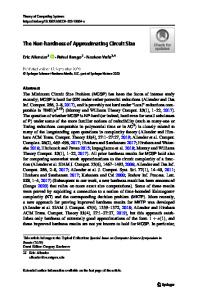Further analysis of the size effect in indentation hardness tests of some metals
- PDF / 600,006 Bytes
- 8 Pages / 576 x 792 pts Page_size
- 54 Downloads / 352 Views
The variation of apparent hardness observed in previously reported Vickers indentation tests of metals is reexamined. Common descriptions of the effect are shown to be inaccurate: the variation of apparent hardness is monotonic but not simple. The effect is consistent with varying size of a previously postulated "plastic hinge" at the perimeter of the indent. This complexity confers uncertainty on the estimation of characteristic macrohardness from small scale tests. Association of the indentation size effect with friction and with strain hardening is confirmed.
I. INTRODUCTION Resistance to permanent deformation, especially deformation by indentation, is described as hardness. For scientific work, indentation hardness is defined as pressure, traditionally as load/indent area (but more precisely as force/area in modern fine work). For indention with a blunt pyramidal (or conical) indentor, the hardness of a material is approximately constant and, therefore, reckoned as simply proportional to the ratio of indenting load to indent area: H =
J. Mater. Res., Vol. 10, No. 11, Nov 1995
http://journals.cambridge.org
Hn =
aL
(d + v) L = Cxd + C2d2 = a(L - 4>d) 0 d2
(2) (3) (4)
(1)
Thus a considerable latitude in test conditions may be tolerated. However, in small scale tests the variation of hardness with indent size is found to be significant. Typical effects observed in low-load (i.e., in the range 10 g to 1 kg) Vickers hardness testing are illustrated by the data for soft aluminum shown in Fig. 1. This variation implies a serious problem for utilization of microindentation or ultramicroindentation tests, which are assuming increasing importance, in thin film technology, for example. The indentation size effect in small-scale indentation hardness testing is most often observed to be a monotonic increase of apparent hardness with decreasing indent size. Sometimes the apparent hardness is reported to rise and fall again as the scale of indentation is reduced, but the credibility of such a complex effect is undermined by the probability of overriding experimental error.1"4 It is difficult to resolve the uncertainty in retrospect, and confusion is compounded by reports of a monotonic size effect with hardness increasing through a similar range for ultramicroindentation testing.5"7 The monotonic size effect has been described8"12 variously by equations containing a constant "error" 2908
parameter modifying the observed load-indentation relationship to give an estimate, Ho, of the supposedly constant characteristic macrohardness, Hx:
Downloaded: 16 Mar 2015
V)
X
.01
Load (kg) FIG. 1. Effects of indent size and of lubrication on hardness of annealed aluminum. © 1995 Materials Research Society IP address: 128.172.10.194
M. Atkinson: Further analysis of the size effect in indentation hardness tests of some metals
derived linear equation In fact, these descriptions have been shown13 to be precisely equivalent (C\ is seen to be identical with ), and this equivalence leads to 7.d 2
(6)
(5)
77 Id + 77 '
A single
Data Loading...











